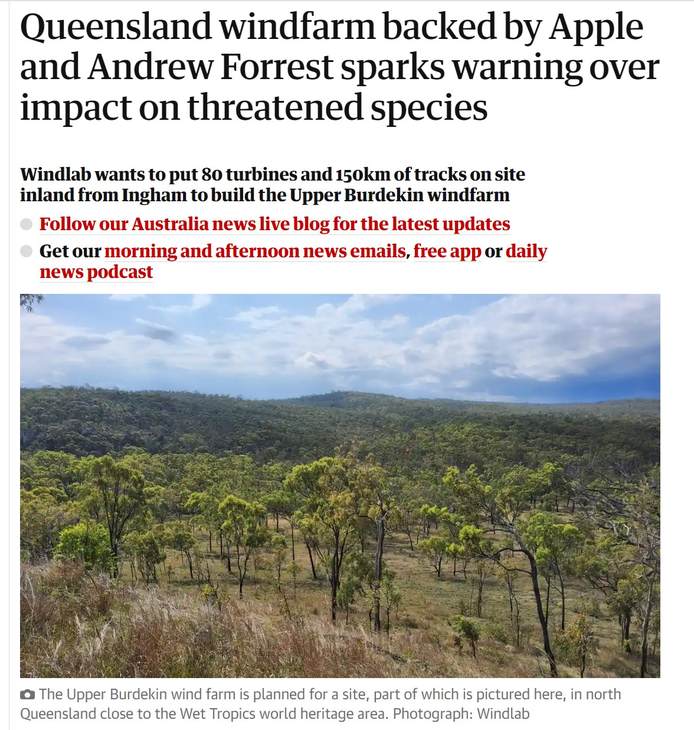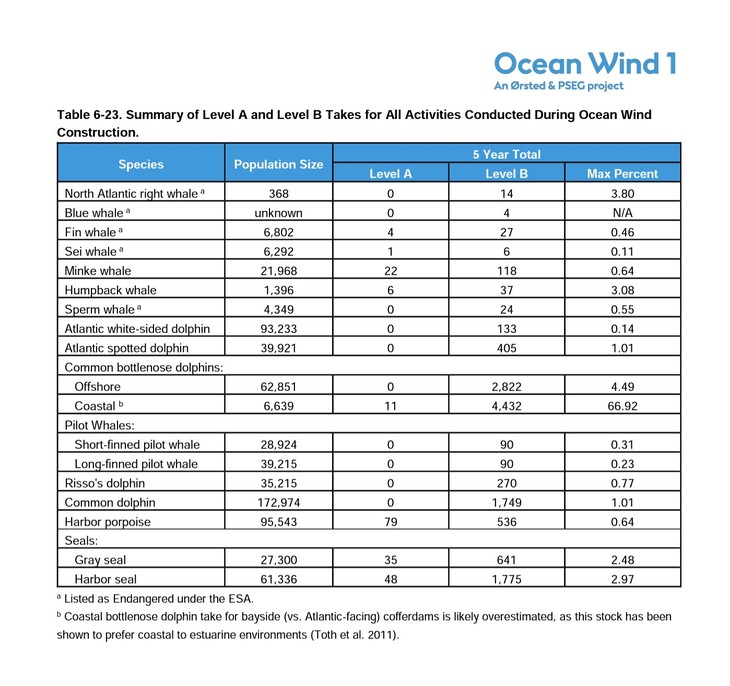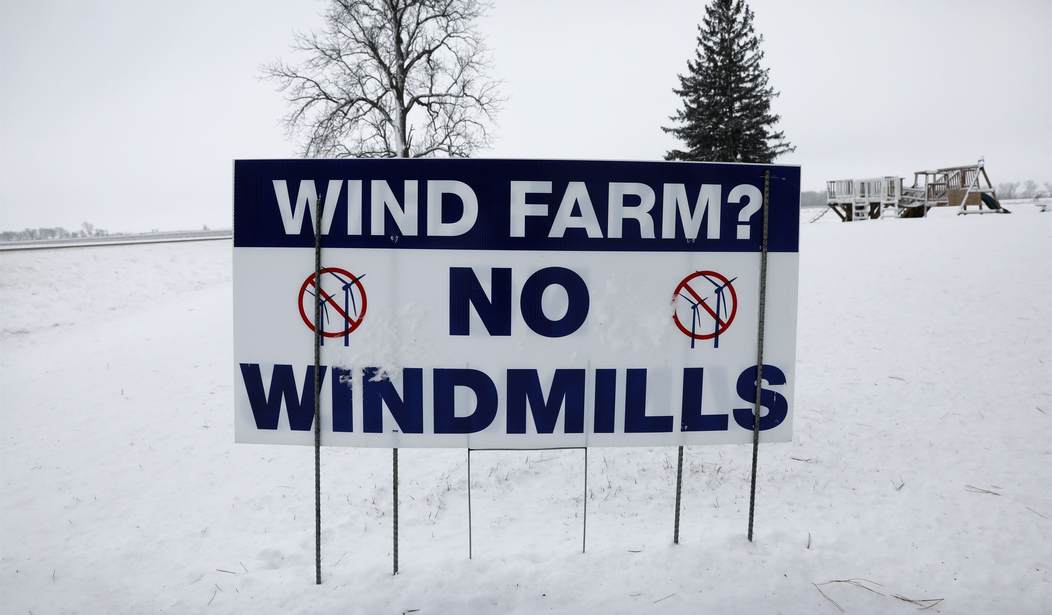Man, tell you what – this is one area I love nothing but bad news for the principles involved, and did I ever get it.
I hardly know where to start, but Down Under’s not a bad place to begin. They’ve got a massive wind farm planned for what seems to be a treasured section of Queensland, and were planning on bulldozing ahead whatever the consequences, because “GREEN.”
SHAME on all the big green groups who failed to oppose Lotus Creek wind farm, Central QLD. This landscape should be a Koala National Park, not an industrial wind complex. We spotted Koalas easily here. Heartbreaking knowing they're homes will be trashed for a wind farm. pic.twitter.com/xSNZlM0aYL
— Rainforest Reserves Australia (@RainforestsAus) March 30, 2023
The billionaire – and Australia’s richest man – who owns 75% of the wind company planning on developing the Preserve (and World Heritage site) had even snagged themselves one of the primo-est of primo customers before a bulldozer lit off. Apple had agreed to buy some 600MW of the power generated by this renewable wonder – it was right up their corporate alley and put the lipstick of legitimacy on the project.
…No lesser being than Tim Cook was moved to say, “We’re proud to celebrate Apple’s long history in Australia, and to deepen our shared commitment to protecting the planet and creating opportunity in people’s lives.”
…It suggested that [billionaire owner Andrew] Forrest’s green energy offering had survived the rigorous due diligence processes of the world’s largest company.
Until the lipstick smeared.
…In January, Windlab’s own draft Public Environment Report contained some indigestible truths about the potential ecological effects of the Upper Burdekin project, including its “unavoidable significant residual impact to Sharman’s rockwallaby, koala, greater glider and red goshawk…”
The red goshawk is Australia’s rarest bird of prey. The koala was also listed as an endangered species in February 2022.
…The draft report also found that the 746 hectares of koala habitat being removed for the wind farm “is considered habitat critical to the survival of the species.”
Headlines like these…

…and Apple was out in a flash. They wanted no part in koala killing. It’s definitely not good for business, so they canceled that 15-year contract and will “continue their search” for renewable energy partners.
Forrest, the billionaire who owns the company, vows to build ahead in spite of the setback, but that remains to be seen. In light of everything rolling downhill in the wind industry itself, I think there may be a pause in koala killing coming.
In Germany, it’s not the forest being pulled down to put the wind towers up – it’s the wind farm coming down. To expand a coal mine.
Best #NetZero chuckle of the day?
Germany demolishing windmills to get at the coal underneath!
Oh the irony.
Oh how the renewablist fanatsists wept with rage..
Nobody wants their junk anymore.
Lovely!https://t.co/t2su1VE8UR
— Latimer Alder (@latimeralder) April 2, 2023
And here’s another facet of the renewables scheme that’s rarely mentioned but is vital underpinning to the entire pyramid – government subsidies. This entire fraudulent enterprise, for all the decades, the billions upon billions of dollars, death, and misery thrown into it, cannot even yet stand on its own.
Wind turbines near the Garzweiler open pit mine in the state of North Rhine-Westphalia, run by German energy giant RWE, is being removed to make way for more lignite exploitation.
The turbines were in operation since 2001, and government subsidies have expired. Energiekontor and wpd, which is also active in the Balkans, operate the wind farm.
…Garzweiler’s annual production is 25 million tonnes, according to RWE. It estimated that lignite reserves in the area could last until 2045. The fuel is mostly supplied to the nearby Neurat thermal power plant.
Back in February, I did a post wondering about wind winding down, and some of the very companies and factors – like inflationary pressures and subsidies – I talked about then are forcing the issue now. One of the companies I mentioned in that piece – Avangrid – was trying to pull out of a contract with the state of New Hampshire to build an offshore wind farm if they couldn’t renegotiate the PPAs or Power Purchase Agreements.
…Commonwealth Wind parent company Avangrid has said for months that increases in commodity prices, rising interest rates and supply shortages mean that its 1,200 megawatt renewable energy project “cannot be financed and built” under the terms of those power purchase agreements (PPAs).
Well, that same company now appears to be in a world of hurt with projects in Massachusetts, again with PPAs at the heart of the disputes.
The ongoing saga of Commonwealth Wind’s future took another twist in late January when it filed with the Massachusetts Supreme Court a petition to set aside the order by the Massachusetts Department of Public Utilities (PUC) issued on December 30, 2022, approving the Power Purchase Agreement (PPA) prices negotiated with the three local utilities purchasing the electricity.
The challenging, worsening economics have upset the future of the project. Avangrid, the developer of the Commonwealth Wind project, wishes to renegotiate the PPA prices or to have them rejected by the PUC which would then allow Avangrid to rebid the project’s output in the next Massachusetts wind power solicitation scheduled for this spring.
…Before Avangrid filed of its petition, Climatewire authored an article about the risk to Massachusetts’ clean energy mandate from the travails of one company – Avangrid. The company has won three of the five major clean energy projects awarded by the state since 2017. The three projects include Mayflower Wind I, Commonwealth Wind, and New England Clean Energy Connect, a transmission line through Maine bringing hydropower from dams in Quebec that would supply 18% of Massachusetts power. The transmission project is mired down in legal battles, while Commonwealth Wind cannot be built because Avangrid cannot raise the money needed, according to its recent filings.
They underbid and then got burned when the economy took a turn for the dumpster and interest rates started upwards. The MA state senate’s budget guru is so pissed, he wants the company banned from doing business with the state.
THE SENATE’S top budget official is calling for Avangrid to be banned from bidding on any future projects in the state if it terminates its current offshore wind contract.
Avangrid agreed to the terms of a 20-year power purchase agreement last year and just before it won final regulatory approval the company stepped forward to say the economy had shifted and it needed more money to make the contract to build Commonwealth Wind work. The Department of Public Utilities rejected that bid, and the company subsequently shifted gears and said it wanted to terminate the existing contract and bid in the state’s next procurement.
Here’s one for legislators – why don’t they quit whining about making their artificial and arbitrarily imposed carbon reduction goals and work on getting it right before blowing any more taxpayer money?
I know. Never happen.
In New Jersey, Gov Phil Murphy’s KILL THE WHALES campaign isn’t going as smoothly as he would like, either. The state legislature got involved in putting the brakes on…
Thank You NJ Rep Chris Smith for caring about the Jersey Shore, the fishing industry, and the sea life and underwater environment off the coast. Smith's amendment to pause and study the massive wind farm construction off the Jersey shore passed with bipartisan support, 244-189. pic.twitter.com/XukPdxOTvQ
— Larry Mendte Show (@LarryMendteShow) March 30, 2023
…their feisty congressional rep is putting his dukes up…
Thank you @Congressman_JVD To execute a offshore wind farm of this monstrous size with no testing and impact studies is irresponsible of @NJBPU @njbpuprez @GovMurphy https://t.co/UxrTpeyx0U
— John Deputato (@johndeputato) April 4, 2023
…NOAA came in with a report that did more harm than good for Orsted and Murphy’s case concerning marine mammals…
AP sports betting reporter @WayneParryAC regurgitates spoon-fed @NOAA propaganda.
If offshore wind is innocent of whale deaths, why do NOAA permits allow the industry to kill endangered whales? https://t.co/uqQFVf4kKH
What are the odds, Wayne?🤔https://t.co/ZmYqemiiV8
— Steve Milloy (@JunkScience) April 5, 2023
(I’m assuming this is NOAA’s version of He’s only MOSTLY dead)
New Jersey’s first offshore wind farm may “adversely affect” whales and other marine mammals, but its construction, operation and eventual dismantling will not seriously harm or kill them, a federal scientific agency said.
*Orsted’s own “Incidental (MOSTLY DEAD) Takes Projections” for the NJ wind farm*

…and an environmental group has filed one of the first lawsuits against NOAA in relation to the project.
Environmental group sues to stop wind farm mapping off Jersey coast. Go @saveLBIorg ! https://t.co/x0LKjJKPH6
— Randall Snyder, MD, MA (@rwsnyder3) April 7, 2023
Even if wind “worked” the numbers it requires don’t.
…Allison explained that wind energy is measured based on the amount of moving air and the speed of the air as it reaches the area swept by the turbine blades.
The scientist calculated that, at 100 percent efficiency, if the wind blows at 10 meters per second (about 22 mph), the power is 600 watts per square meter. Hence, to deliver 3,200 million watts, the same output as Hinkley Point C—a planned zero-carbon nuclear power station in England—there would need to be 5.5 million square meters* of turbine swept area.
“That should be quite unacceptable to those who care about birds and to other environmentalists,” Allison wrote.
The actual performance of the technology is much worse than the calculations made based on 100 percent efficiency, he said.
“Because the power carried by the wind depends on the third power of the wind speed, if the wind drops to half speed, the power available drops by a factor of 8,” he said. “Almost worse, if the wind speed doubles, the power delivered goes up 8 times, and as a result the turbine has to be turned off for its own protection.”
*UPDATE From GlobalTrvlr in the comments correcting my crappy math and the emphasis is mine:
I believe your Calc of 2 sq miles for 5.5MM sq meters is way off. If I am reading Allison right, and I read his article, the area he is talking about is the area of the blades, so the area of the each wind turbines spinning diameter. Average rotor diameter is 127 meters for offshore. Area of that swept area is about 400 sq meters. 5.5MM sq meters ==> 13, 750 turbines. Turbines have to be spaced at least 5 x rotor diameter side-side and 8x front to back. I will let you do the rest of the math, but it is many sq miles.
5.5M sq meters translates to just over 2 sq miles. The nuclear reactor in England they use for comparison sits on a site that’s just a shade over a half a mile square (400 acres), giving wind turbines a 4 to 1 land use ratio. NTM the reactor runs continuously, as opposed to when wind doesn’t blow, or it blows too much, or things freeze, shutting the turbines down completely.
Talk about the wind out of their sails.
What a great week!









Join the conversation as a VIP Member